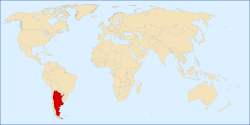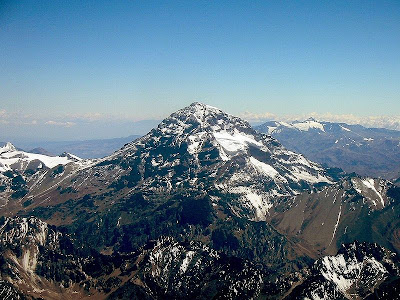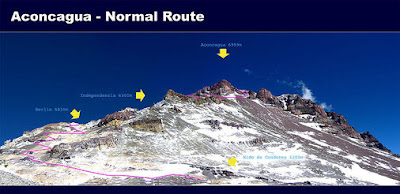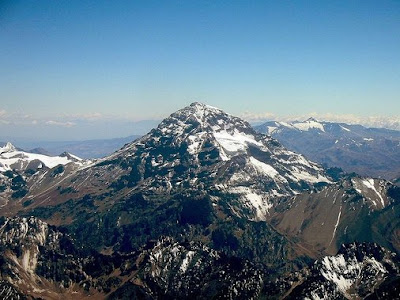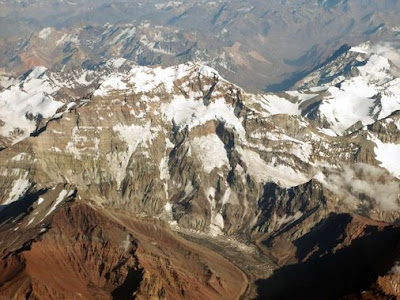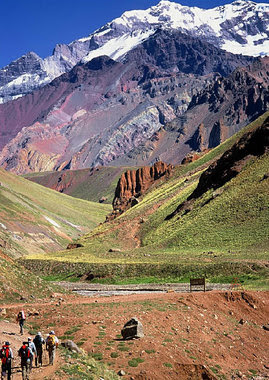Aconcagua
|
|
|
Cerro Aconcagua is the highest mountain in the Americas. It is located in the Andes mountain range, in the Argentine province of Mendoza. The summit is located about 5 kilometres from San Juan Province and 15 kilometres from the international border with Chile. It lies 112 km (70 mi) west by north of the city of Mendoza. Aconcagua is the highest peak in both the Western and Southern Hemispheres, as well as the highest outside of Asia. It is one of the Seven Summits.
Aconcagua is bounded by the Valle de las Vacas to the north and east and the Valle de los Horcones Inferior to the West and South. The mountain and its surroundings are part of the Aconcagua Provincial Park. The mountain has a number of glaciers. The most substantial are the north-eastern or Polish Glacier and the eastern or English Glacier.

The mountain was created by the subduction of the Nazca Plate beneath the South American plate during the geologically recent Andean orogeny; however, it is not a volcano. The origin of the name is contested, it is either from the Arauca Aconca-Hue, which refers to the Aconcagua River and means 'comes from the other side' or the Quechua Ackon Cahuak, meaning 'Sentinel of Stone'.
In mountaineering terms, Aconcagua is technically an easy mountain if approached from the north, via the normal route. Although the effects of altitude are severe (atmospheric pressure is 40% of sea-level at the summit), the use of supplemental oxygen is not required.
The second most frequented route is the Polish Glacier Traverse route. This approaches the mountain through the Vacas valley, ascends up to the base of the Polish Glacier, then traverses across to the normal route for the final ascent to the summit.
The routes to the peak from the south and south-west ridges are more demanding and the south face climb is considered very difficult.
Before attempting the mountain climbers need to purchase a permit from the Aconcagua Provincial Park authority in Mendoza. Prices vary depending on the season.
The camp sites on the normal route are listed below. (altitudes are approximate)
-
Puente del Inca, 2,740m (8,990ft): A small village on the main road, with facilities including a lodge.
-
Confluencia, 3,380m (11,090ft): A camp site a few hours into the national park.
-
Plaza de Mulas, 4,370m (14,340ft): Base camp, claimed to be the second largest in the world (after Everest). There are several meal tents, showers and internet access. There is a lodge 500 metres from the main campsite.
-
Plaza Canadá, 5,050 metres (16,570 ft): A large ledge overlooking Plaza de Mulas.
-
Plaza Alaska, 5,200 metres (17,060 ft): Called 'change of slope' in Spanish, a small site as the slope from Plaza de Mulas to Nido de Cóndores lessens. Not commonly used.
-
Nido de Cóndores, 5,400 metres (17,720 ft): A large plateau with beautiful views. There is usually a park ranger camped here.
-
Berlín, 5,900m (19,360ft): The usual high camp. Windy and exposed, and quite filthy. Many climbers avoid it, and stay slightly higher at Piedras Blancas.
It is common to spend at least one night in Confluencia while trekking to base camp in order to acclimatise properly. Summit attempts are usually made from a high camp at either Nido de Cóndores or Berlín. Although Berlín is closer to the summit, many climbers find that they rest better at Nido and are able to make up for the lost time. Some well-acclimatised climbers also pitch their high camp even further up the mountain, at Piedras Blancas (~6,000m) or near Independencia (~6350m).
History.
The first attempt on Aconcagua by a European was made in 1883 by a party led by the German geologist and explorer Paul Güssfeldt. Bribing porters with the story that there was treasure on the mountain, he approached the mountain via the Rio Volcan, making two attempts on the peak by the north-west ridge and reaching an altitude of 6,500 metres (21,300 ft). The route that he prospected is now the normal route up the mountain.
The first recorded ascent was in 1897 on a British expedition led by Edward Fitzgerald. The summit was reached by the Swiss guide Matthias Zurbriggen on January 14 and by two other expedition members a few days later.
Popular culture.

-
The mountain has a cameo in a 1943 Disney cartoon called Pedro. The cartoon stars an anthropomorphic small airplane named Pedro who is compelled to make an air mail run over the Andes and has a near-disastrous encounter with Aconcagua. The mountain (also anthropomorphic, and scary-looking), later appeared in an illustration used in a retelling of the story in a Disney anthology book.
Note
-
The possibility of a previous ascent, even a precolumbian Llullaillaco, were ascended for ceremonial purposes in Inca
ascent, cannot be discounted, although no definitive evidence of such an ascent exists. Animal remains have been found high on the mountain, and peaks almost as high as Aconcagua, such as times.

